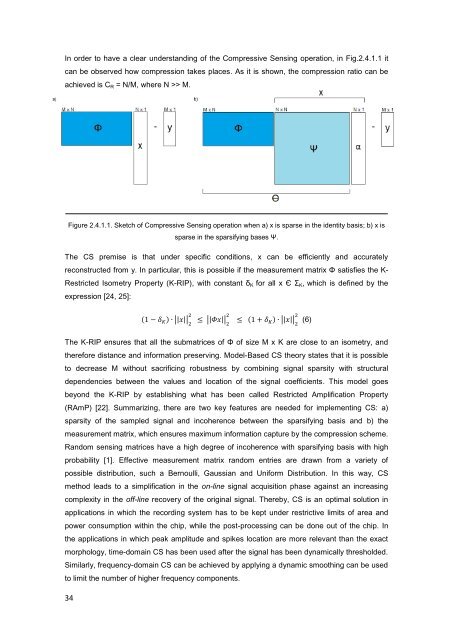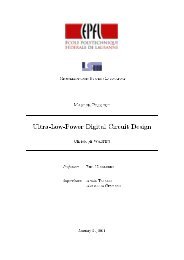Compressive Sensing system for recording of ECoG signals in-vivo
Compressive Sensing system for recording of ECoG signals in-vivo
Compressive Sensing system for recording of ECoG signals in-vivo
Create successful ePaper yourself
Turn your PDF publications into a flip-book with our unique Google optimized e-Paper software.
In order to have a clear understand<strong>in</strong>g <strong>of</strong> the <strong>Compressive</strong> <strong>Sens<strong>in</strong>g</strong> operation, <strong>in</strong> Fig.2.4.1.1 itcan be observed how compression takes places. As it is shown, the compression ratio can beachieved is C R = N/M, where N >> M.Figure 2.4.1.1. Sketch <strong>of</strong> <strong>Compressive</strong> <strong>Sens<strong>in</strong>g</strong> operation when a) x is sparse <strong>in</strong> the identity basis; b) x issparse <strong>in</strong> the sparsify<strong>in</strong>g bases Ψ.The CS premise is that under specific conditions, x can be efficiently and accuratelyreconstructed from y. In particular, this is possible if the measurement matrix Φ satisfies the K-Restricted Isometry Property (K-RIP), with constant δ K <strong>for</strong> all x Є Σ K , which is def<strong>in</strong>ed by theexpression [24, 25]:(6)The K-RIP ensures that all the submatrices <strong>of</strong> Φ <strong>of</strong> size M x K are close to an isometry, andthere<strong>for</strong>e distance and <strong>in</strong><strong>for</strong>mation preserv<strong>in</strong>g. Model-Based CS theory states that it is possibleto decrease M without sacrific<strong>in</strong>g robustness by comb<strong>in</strong><strong>in</strong>g signal sparsity with structuraldependencies between the values and location <strong>of</strong> the signal coefficients. This model goesbeyond the K-RIP by establish<strong>in</strong>g what has been called Restricted Amplification Property(RAmP) [22]. Summariz<strong>in</strong>g, there are two key features are needed <strong>for</strong> implement<strong>in</strong>g CS: a)sparsity <strong>of</strong> the sampled signal and <strong>in</strong>coherence between the sparsify<strong>in</strong>g basis and b) themeasurement matrix, which ensures maximum <strong>in</strong><strong>for</strong>mation capture by the compression scheme.Random sens<strong>in</strong>g matrices have a high degree <strong>of</strong> <strong>in</strong>coherence with sparsify<strong>in</strong>g basis with highprobability [1]. Effective measurement matrix random entries are drawn from a variety <strong>of</strong>possible distribution, such a Bernoulli, Gaussian and Uni<strong>for</strong>m Distribution. In this way, CSmethod leads to a simplification <strong>in</strong> the on-l<strong>in</strong>e signal acquisition phase aga<strong>in</strong>st an <strong>in</strong>creas<strong>in</strong>gcomplexity <strong>in</strong> the <strong>of</strong>f-l<strong>in</strong>e recovery <strong>of</strong> the orig<strong>in</strong>al signal. Thereby, CS is an optimal solution <strong>in</strong>applications <strong>in</strong> which the <strong>record<strong>in</strong>g</strong> <strong>system</strong> has to be kept under restrictive limits <strong>of</strong> area andpower consumption with<strong>in</strong> the chip, while the post-process<strong>in</strong>g can be done out <strong>of</strong> the chip. Inthe applications <strong>in</strong> which peak amplitude and spikes location are more relevant than the exactmorphology, time-doma<strong>in</strong> CS has been used after the signal has been dynamically thresholded.Similarly, frequency-doma<strong>in</strong> CS can be achieved by apply<strong>in</strong>g a dynamic smooth<strong>in</strong>g can be usedto limit the number <strong>of</strong> higher frequency components.34















